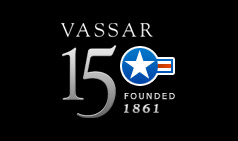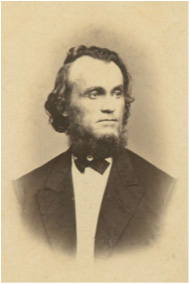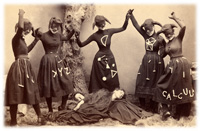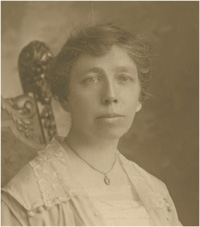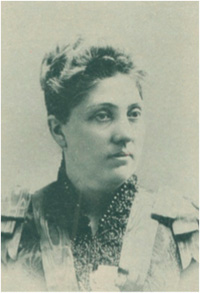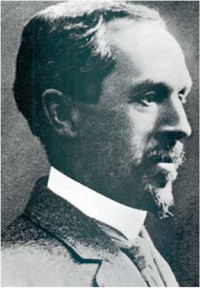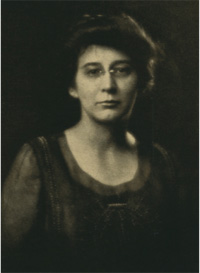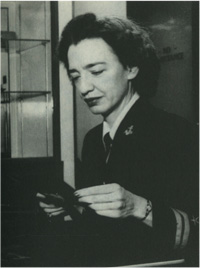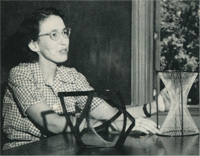The History of Mathematics at Vassar College
by John McCleary
January 2011
Department Website
“The object of this College, as stated by its founder, is to accomplish for young women what colleges of the first class accomplish for young men, that is, to furnish them the means of a thorough, well-proportioned, and liberal education, adapted to their wants in life.” This quote from the first Vassar Catalogue of 1865 had the implication in those times that Mathematics would be a central subject in the curriculum of a Vassar student as it would have been for young men at colleges elsewhere. The Department of Mathematics at Vassar Female College began as part of the Department of Mathematics, Natural Philosophy and Chemistry in the 1865 catalogue. It was led by Charles Farrar (1826-1908) with Priscilla Braislin (1838-1888) who taught with one or two other teachers on short term contracts. Farrar had been hired from Elmira Female College in 1863 and he supervised the building of the Old Observatory for Maria Mitchell. After the announcement of the founding of Vassar in 1861 there were at least another dozen applicants for the post of chair whose recommendations came from pastors, testifying to the moral character of the applicant. In fact, Farrar was known for his Sunday sermons given on campus.
The first mathematics curriculum can be reconstructed from the textbooks assigned, which are listed in the early catalogues. At first Algebra, Geometry, and Trigonometry were required of all freshmen and sophomores. These subjects were followed by Analytical and Descriptive Geometry and the Calculus. The sophomores who finished their required mathematics warned the freshmen of the rigors to come in an annual play called the Trig Ceremonies.
Vassar’s training was very rigorous and served the first students well. To give an idea of the educational situation at the time, there were only 10 PhD’s awarded to US women in Mathematics before 1900. Charlotte Barnum (1860-1934), VC 1881, received the first degree in Mathematics awarded by Yale University to a woman. However, the first work acknowledged to be worthy of a PhD in Mathematics was completed in 1882 at Johns Hopkins University by Christine Ladd-Franklin (1847-1930), VC 1873. The Board of Trustees of the university would not award her a PhD because she was a woman. She traveled to Europe in 1891 and began studies in Psychology, in particular, on a theory of color vision that made her famous. In 1926 Johns Hopkins University planned to award her an honorary degree for her contributions to Psychology. She preferred and was granted the doctorate that she had earned 44 years earlier in Mathematics. In 1887 Vassar College awarded Ladd-Franklin an LLD, the only honorary doctorate bestowed by the College in its history.
After the departure of Charles Farrar in 1874 Priscilla Braislin was the Chair of the Department of Mathematics and the first Professor of Mathematics at the college. She resigned in 1887 and the post was filled by Achsah Mount Ely (1846-1904), VC 1868. Ely had taught in secondary schools and a normal college in New York before her appointment at Vassar. She did graduate work at Newnham College, Cam-bridge and the then Chicago University. She was a member of the American Mathematical Society from its beginning in 1891, when it was known as the New York Mathematical Society. During her time as chair Ely outlined the mission of the department, resulting in the statement found in the 1894-95 catalogue:
The aim in all courses is to cultivate habits of exact, sustained and independent reasoning, of precision and clearness in the statement of convictions and the reasons upon which they depend; to rely upon insight, originality and judgment rather than on memory. The endeavor is to secure full possession of leading principles and methods rather than of details. From the first, students who show special aptitude are encouraged in the working of subjects, which require more prolonged investigation than the daily exercise of the class-room.
Faculty and students of Mathematics since then have sought these aims, and they apply as well today.
Ely had a strong interest in expanding the offerings of the mathematics department, to provide the “elastic character of the curriculum of the college” with “modern mathematical thought.” Students were studying solid analytic geometry for which visualization of algebraic surfaces is an important skill to acquire. She obtained funds to buy the plaster-of-Paris models manufactured by Brill and Schilling in Darmstadt that are on display in Rockefeller Hall. Our collection was used in classes through the 20th century, and the models are now rare and valuable.
Although she did not have a doctorate in mathematics, Achsah Ely was thoroughly engaged in the subject, even at the international level. She attended the second Inter-national Congress of Mathematicians held in Paris in the summer of 1900, one of seven women among the 250 or so participants listed in the proceedings.
Under the leadership of Ely, the first PhD in mathematics was hired into the department. Ruth Gentry (1862-1917) obtained the first PhD awarded to a woman by Bryn Mawr College in 1896, having studied in Berlin and in Paris before taking a position at Vassar in 1894 where she taught until 1902. Around this time the college offered opportunities for graduate study, which included advanced courses on Projective Geometry, Differential Equations, and Modern Methods of Analytics. Seniors studied Advanced Integral Calculus, the Quaternions, and Analytic Mechanics.
After the death of Achsah Ely in 1904, Henry Seely White (1861-1943) was appointed Professor and Chair. White finished his undergraduate studies at Wesleyan University in 1882 and went to Göttingen where he received a PhD in 1891 under Felix Klein (1849-1925). White taught at Clark University for two years before he was called to Northwestern University where he worked until joining the Vassar faculty in 1905. In Chicago he was involved in organizing the first International Congress of Mathematicians, which took place in conjunction with the famous World Exposition of 1893. White was instrumental in bringing Klein to lecture at the World’s Fair. A distinguished geometer, White served as the president of the American Mathematical Society 1906-1908 and he was named a Fellow of the National Academy of Sciences in 1915.
During White’s years as chair, the department grew to four instructors, including Sophia Richardson (1862?-1916) VC 1879, who was succeeded by Mary Evelyn Wells (1881-1965), Gertrude Smith (1874-1965) VC 1901, MA 1902, Elizabeth B. Cowley (1874-1945) VC 1901, MA 1902, and Louise Duffield Cummings (1870-1947). Between 1900 and 1940, 219 women earned PhD’s in mathematics at US universities, 14.3% of all PhD’s awarded during these years. Thanks to undergraduate programs like the one at Vassar College, women gained access to graduate programs in mathematics although not many programs granted degrees to women. Notable among the exceptions was the University of Chicago, founded in 1892 with a commitment to coeducation. Wells earned her PhD from Chicago in 1915, Cowley from Columbia in 1908, and Cummings from Bryn Mawr in 1914. All of the women on the faculty of mathematics studied some time in Chicago during this period.
The most well known graduate of the department of mathematics at Vassar College studied during these years; Grace Murray Hopper (1906-1992) VC 1928, was supported as a Vassar Fellow to study at Yale where she took a Master’s degree in 1930 and a PhD in 1934. She joined the department in 1931 where she taught until 1944, leaving to a commission in the Navy as a member of the WAVES (Women Accepted for Volunteer Emergency Service). She was sent to Harvard to assist in the development of the MARK I, II, and III computers at Harvard. After the war she continued her involvement in computers at Harvard until 1949 when she joined Eckert-Mauchley Computer Corporation as a senior mathematician. The company was bought by the Rand Corporation and she began to work on the first commercial computer UNIVAC. She suggested that programming be done in a standardized, natural language. She developed FLOW-MATIC which later became the basis for COBOL. In 1966 she was forced to retire from the Navy at age 60, but she was called back into active duty to lead a project to standardize the Navy’s use of COBOL. She remained on active duty until 1986, achieving the rank of Rear Admiral at her retirement. She received many honors in her life; she was awarded the National Medal of Technology, and the Navy christened a ship, a missile destroyer, the USS Hopper.
While at Vassar, Hopper was an innovative teacher. In 1940 she and her Descriptive Geometry students made a movie to animate a plane curve. The New York Times reported on the film. During the war the Mathematics Department participated in the effort by offering a secret elective course, taught by Mary Evelyn Wells, on cryptography. Students of the course were chosen for ability in mathematics and languages and they were expected to enter the Navy upon graduation to work in communications and decoding.
The next generation of the Department of Mathematics joined the faculty in the 1940’s. They were hired by Mary Wells, who became the chair of department after White retired. The strong support of the University of Chicago for women shows in the appointments: Janet McDonald (1905-2006), Frances E. Baker (1902-1995), and Abba V. Newton (1908-1996) all earned their PhD’s there. The fourth ongoing member of the department was a Vassar grad from the class of 1938, Winifred Asprey (1917-2007), who earned a PhD from the University of Iowa in 1945. Asprey was particularly influenced by her former teacher, Grace Hopper, who inspired her to study computers. Her successful efforts to bring computing into Vassar’s curriculum made Vassar one of the first liberal arts colleges to establish a computer center (with a then cutting-edge IBM 360), to offer courses in computer science, and to involve students in internships at the budding industry. She wrote in 1967, “Familiarity with a computer will be as commonplace as familiarity with a foreign language presently is.” She was the first person to hold an IBM Post-Doctoral Industrial Research Fellowship (1957-58) with which she studied computer science with the developers and participated in conferences and research. The legacy of her pioneering work may be found on campus today in the Asprey Advanced Computation Laboratory, and the Asprey Distinguished Lecture Series in Mathematics, and in Computer Science.
Asprey was involved with campus issues throughout her career, including sitting on the committee that drew up the Vassar-Yale Study of 1967. The idea of moving Vassar to New Haven to become a part of Yale was a flawed idea from the start. However, the study did reveal the strong student interest in a coed classroom experience, together with the rejection of the arguments for single-sex colleges. The move to coeducation in 1969 was accomplished by expanding the population from 1550 students to 2250 for whom new faculty were needed. David Merriell (1919-2008), another University of Chicago PhD, joined the department as a professor in 1968, having taught at Robert College in Istanbul and the University of California, Santa Barbara. In 1969 numerous visiting faculty filled out the department to meet the new students. With retirements in the 1970s the next generation of the department was in place by the 1980s, and this group includes many of the present faculty.
Mathematics is a discipline that changes very slowly and so ideals for teaching and scholarship for the late 19th century and the 21st century can be compared. It is remarkable to me that Achsah Ely’s goals for the students of mathematics are as applicable today as they were over a century ago. The high standard of achievement set by previous generations of department members continue to inspire the faculty. Henry Seely White’s presidency of the AMS has a parallel in Charles Steinhorn’s service as secretary/treasurer of the Association of Symbolic Logic; Sophia Richardson’s well-received book Solid Geometry grew out of her teaching and reached a wider audience, as did Calculus: A Programmed Text by David Merriell, Single-Variable Calculus by John Feroe and Charles Steinhorn, and Geometry from a Differentiable Viewpoint by John McCleary; White’s influential Plane Curves of the Third Order led researchers into the area developed by White in algebraic geometry and McCleary’s User’s Guide to Spectral Sequences does a similar job for algebraic topology. The principle of encouraging talented students to more prolonged investigations remains vital in the mathematical projects supported by URSI, which has engaged around 100 students, with 90% going on to have careers in science-related areas and 60% attending graduate schools with careers in mathematics-related disciplines. From 2003-2008, Peter Pappas served as URSI. Participation by the faculty in research on the international stage continues apace and some of those developments make their way into the classroom. For the dozen or so majors who graduate each year the same support that made Vassar a force in encouraging women to continue their studies in mathematics is available to make them ready for graduate work and for the other challenges after graduation in which mathematics is essential.
References
- Green, J. and LaDuke J., Women in the American Mathematical Community: The Pre-1940 Ph.D.’s, Mathematical Intelligencer 9(1987), 11-23.
- Green, J. and LaDuke J., Pioneering Women in American Mathematics: The Pre-1940 PhD’s, American Mathematical Society, 2009, Providence, Rhode Island.
